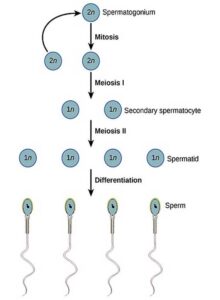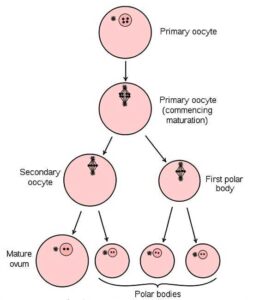Gametes are produced by the animals through meiosis cell division from diploid mother cells (gonads). There are two types of gonads such as testis in males and ovaries in females. The process of gamete production (ovum and sperm) is known as gemetogenesis (Gr. Gamos=marriage; genesis=origin).
Testes produce male gametes or sperms through the process of spermatogenesis while ovaries produce ovum or female gamete through the process of oogenesis.
In this case, sperms and ova are produced from the germinal epithelial cells of the testes and ovaries of sexually matured male and females, respectively.
Spermatogenesis
Males can produce sperm when they reach puberty at the age between 10-16 years old. Approximately 200 million sperms produce in a day. These sperms happen in the seminiferous tubules of the testes of male. In this case, the seminiferous tubules are separated by the blood-testis barrier from the systematic circulation.
The spermatogenesis is a process to produce sperms which occurs in the male gonads or testes. The human testes consist of many seminiferous tubules which are lined by the cells of germinal epithelium.
This germinal epithelium plays an important role to produce sperms through the process of spermatogenesis. The germinal cell also contains some somatic cells, known as sertoli cells which have a role in nourishing the developing spermatozoa or sperms.

Image Showing Spermatogenesis Process: Image credit-wikimedia commons
The spermatogenesis is a continuous process and it can be described in four different headings:
- 1. Multiplication Phase
- 2. Growth Phase
- 3. Maturation Phase and
- 4. Spermiogenesis
Multiplication Phase
The male germinal cells are also referred to as the primordial cells or primary germinal cells and they can produce the sperms. These primordial cells reproduce by repetitive mitosis cell division and produce the diploid (2n) cells, known as spermotagonia.
There are two types of spermatogonia such as A1 spermatogonia and B type spermatogonium. In this case, B type spermatogonium finally forms mature sperm.
Growth Phase
In this phase, B type spermotogonial cells gather huge quantity of chromatin substance and nutrition. They multiply several times by mitosis and form identical diploid (2n) cells. These cells are now known as primary spermatocytes.
Maturation Phase
In this phase, each primary spermatocytes then undergoes meiosis-I and produces two haploid (n) cells, known as secondary spermatocytes. Each secondary spermatocyte goes through the Meiosis-II and produces four haploid (n) cells, known as spermatids.
As a result, four haploid spermatids are produced from a diploid (2n) spermatogonium through a meiosis or maturation division. Spermatids have unflagelatted and round shaped-body which form motile haploid (n) sperms or spermatozoa through maturation.
Spermiogenesis
Spermiogenesis is the maturation process of the spermatids into sperm cells through the complex process. During this phase, the following modification occurs in the spermatids:
- The non-motile, round, more cytoplasmic spermatids transformed into motile, elongated, less cytoplasmic sperms.
- The nucleus of spermatid shrinks and discards water; RNA and nucleolus form the head of the sperm.
- To form acrosome of the sperm, the golgi apparatus comes together near the anterior end of the sperm nucleus.
- The mitochondria become spiral to form the middle part of the sperm.
- The two centriols of the spermatids form the axial filament and tail of the sperms.
- The entire process of spermatogensis takes about 70 days to form sperm from spermatogonium.
- The sperms are stored and become functionally mature in the epididymis.
- 200-300 million sperms are produced from one ejaculation, of which 40% are motile and 60% non-motile.
Difference Between Spermatogenesis and Spermiogenesis
|
Spermatogenesis |
Spermiogenesis |
|---|---|
| Motile spermatozoa are formed from spermatogonium through the process of spermatogenesis. | Mature spermatozoa are produced from spermatids through the process of spermiogenesis. |
| A spermatogonium produces four functional spermatozoa through the spermatogenesis. | A spermatid can produce one spermatozoon through the spermiogenesis. |
| To complete the spermatogenesis process, it includes the following phases: multiplication phase, growth phase, maturation phase, and a differentiation phase. | It includes only differentiation process. |
| It is the complete process to produce mature sperm cells from the primordial germ cells. | It is the part of spermatogenesis where mature spermatozoa are produced. |
| In this process, haploid (n) gametes are produced from diploid (2n) germ cells. | It happens in the haploid (n) cells and no changes occur in the amount of genetic material through this process. |
| In this case, growth and divisions occur. | Growth and division do not occur. |
Oogenesis
Oogenesis is the process for producing ovum. It occurs in the cells of the germinal epithelium of the ovary. These cells are known as primary germinal cells or primordium cells. The oogenesis process is completed in the following four successive stages:
Multiplication Phase
The primordial cells or primary germinal epithelium multiply by the repeated mitosis cell division and produce many diploid (2n) oogonia(singlular: oogonium).
Growth Phase
In this phase, oogonia receive nutrition and become massive large in size. During this period, synthesis of different cellular organelles happens. Along with the growth in size, the nuclei of the oogonia undergo first prophase of the meiosis cell division.
In this stage, egg cells are known as primary oocyte. Oocyte development takes place within follicles.

Image Showing Ogenesis: Image credit-Wikimedia
Maturation Phase
The maturation phase is accomplished by the maruration or meiotic division. After the meiosis-I, the primary oocyte divides unequally to produces a large-sized haploid (n) secondary oocyte and a small-sized haploid(n) first polar body.
The secondary oocyte passes through the metaphase stage of meiosis-II to forms a large mature ootid and a small polar body.
The first polar body also divides into two secondary polar bodies through the meiosis-II. As a result, a diploid primary oocyte produces one large haploid (n) ootid and three small haploid (n) polar bodies through maturation phase.
Metamorphosis Phase
In this phase, the ootid is modified into a mature ovum. But in this case, no huge changes occur as like in spermatid. A few changes held in the internal component for fertilization.
The polar bodies ooze out from the egg and degenerate while the haploid (n) non-motile, large and spherical ovum ready for fertilization.
In the ovary of a female foetus, 7 million primary oocytes forms, but at the time of birth they reduce to 2-4 millions. 40,000 primary oocytes left out at puberty. Approximately 400 ova are produced throughout the female life.
Difference between Oogenesis and Spermatogenesis
|
Oogenesis |
Spermatogenesis |
|---|---|
| It is the process for production of sperms from spermatogonia. | It is the process for production of ova from oogonia. |
| This process happens in the ovaries of the females. | It happens in the testes of the males. |
| It starts during fetal development. | It starts at puberty. |
|
Maximum stages occur in the ovary and last few in oviduct. | All stages occur in testes. |
| It is an irregular process and occurs after the puberty until menopause. | It is a nonstop process and occurs after the puberty till death. |
| At menopause, fertility stops. | Fertility does not stop but it reduces in aged. |
| Each meiosis cell division produces one gamete. | Each meiosis cell division produces four gametes. |
| In this process, non-motile gametes are produced. | Motile gametes are produced. |
| In this case, unequal cytokinesis occurs. | In this process, equal cytokinesis occurs. |
| One gamete or ovum is produced. | Four male gametes or sperms are produced. |
| Four polar bodies are formed. | No polar bodies are produced. |
| Gamete produces in monthly cycle. | Gamete produces in any time. |
| In this process, growth phase is long. | Growth phase is too short. |
| Ovum holds lot of food reserve. | Sperm hold less food reserve |
